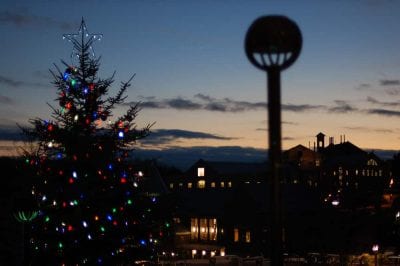My family has the unique claim of being the March family from Little Women. That, or the closest thing to it: four sisters and their mother. Of course, each sister doesn’t line up quite perfectly with her counterpart in Louisa May Alcott’s book. There are strangely similar attributes though, like the fact that we tend to pair off into “the bookends” and the two middle sisters. Perhaps this is why Christmas is particularly special for our family: because that’s where the story begins.
Just as the March sisters had their traditions, so did the Thatcher sisters. And I’m convinced that it was these traditions that helped me transition from childhood to young adulthood, and eventually find Catholicism.
We grew up in the Episcopalian church, and when we were children, one of the highlights of the season was driving to the Episcopal cathedral in Portland, Oregon for Lessons and Carols at the start of Advent. The church, with big red doors and gothic architecture, symbolized the beginning of celebrations for me. Every year, that first night was a special treat because after the service, our parents took us out to eat cake at Rose’s Café and Bakery. There was something thrilling to my child’s mind about walking around downtown Portland late at night with the Christmas lights in the trees and the pavement wet from the latest rainfall.
Then the music began. My sisters and I still tease each other if we catch someone listening to a Christmas song before December. There were, growing up, very specific rules about when certain CDs could be played. Our favorite CDs are by Manheim Steamroller, which could only be played at the start of December. The second CD is saved for decorating the tree, and the third for opening presents on Christmas morning. Only once those songs are played does it feel like Christmas.
Christmas Eve, which never used to come too fast but always does now, has always been my favorite family day of the year. Last-minute gift wrapping sessions; mom reading the final chapter of “A Christmas Carol,” (an Advent tradition); and feasting on tangerines and Christmas cookies. Then, we all assembled a corner of a large puzzle called “The Night Before Christmas,” depicting the story in the poem. It’s so familiar to us that we can put it together in an hour. We ended, if I got my way, singing around the piano in darkness with candles lit—just like in the Little Women movie.
Growing up, I lived for these traditions. I would stay awake half the night on Christmas Eve imagining every detail, over and over, of what the next day would bring, until it was just right. Sometimes, I scarcely slept at all. Naturally, nothing ever played out the way I imagined. And yet, every year, no matter how many times I snuck down the stairs to empty the bulging stocking in my imagination, I was still sleepless with anticipation of the real thing.
It was tempting to feel that the “magic” of Christmas had died when some of those accompanying traditions died: When I learned Santa was a fake (yes, I was 12 by the time I learned this), when we stopped going to Lessons and Carols—when, it seemed, my feelings for the season dissipated.
But then, Catholicism, with all its traditions and genius and beauty, entered my life. And with it: the true wonder of Christmas.
As I was lying awake those many Christmas Eves, I was longing for the real thing: the truth beyond the presents and the material. Even as a child, amid the unpacking of stockings and the unwrapping of presents, there was something unsatisfying about being finished, about having to wait until next year for more.
It’s truly through the genius of the Holy Spirit that I began to seek out a genuine relationship with Jesus Christ right when the innocence of childhood was ending. This doesn’t mean I didn’t suffer a great deal of disillusionment. I often felt in the following years like I was grasping at Christmas, which was quickly fleeing with my childhood. I thought I would never get the feelings back, or know how I could replace them.
As humans, and as children at Christmas, we try to find meaning in the material. This is because we’re made up of body and soul, and the physical reveals truth to us about the spiritual. Jesus Christ, in his Incarnation and birth, brought the two together to show us the significance of proper order for the two. The Catholic Church, with her sacraments as visible signs of the invisible truths, brought these together for me in a way I had never known before.
It took me many years to understand that it wasn’t the actions of the traditions or the “Christmas spirit” that I loved, but rather the higher reality toward which they point. Those traditions ultimately pointed me to the Catholic Church, and her traditions serve the same purpose, like that star over Bethlehem 2000 years ago: a beacon to Jesus Christ.
I will go home this year for the last time as a college student. This might also be the last time my mom’s “little women” will be home all at the same time, and I’m honestly having a hard time with the thought of more traditions falling away or changing. But just as I have come to know that the holiday isn’t just about the feelings, so I will continue to live in the reality of what the spirit indicates—unwrapping the truth in tradition, and not just the moment.
Allegra Thatcher is a senior English major at Franciscan University.





